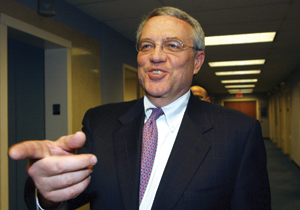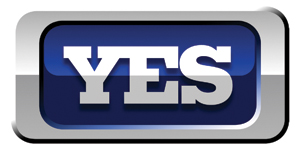YES at 10: Escalating sports rights. Explosion of sports channels. High-cost regional sports networks. Many in the industry trace these to 10 years ago this spring when YES Network launched in the New York market. In its decade of existence, YES Network has changed the way sports leagues and teams handle their media rights. Here’s a look at how the network launched and influenced the marketplace.
SPORTS MEDIA: How original YES execs helped shape sports media landscape.
At first, The Boss said “no” to YES.
At least, that’s what former MSG President Bob Gutkowski recalls about the first time he pitched Yankees owner George Steinbrenner on building his own cable network instead of just taking a check from the highest bidder.
In the case of the New York Yankees, that was already a very large check. MSG roiled the cable and sports industry in 1988, when it paid $493 million for the rights to telecast the Yankees on cable from 1989-2001. At the time, those fees were considered by many to be so extraordinary that they would lead to the ruination of both a developing cable television business and baseball itself, since the deal brought the Yankees wealth that no other team could imagine.
Instead, the MSG deal actually set a foundation for regional sports networks like YES Network, since it moved the rights of the top MLB team in the No. 1 market off of SportsChannel’s exclusive pay tier to a more widely distributed network.
“A reporter called me that day and asked me how it felt to be the man who ruined baseball,” said Gutkowski, who negotiated the Yankees/MSG deal and who is now a consultant, and a partner at private equity firm Innovative Strategic Management.
Seven years later, after leaving MSG, Gutkowski met with Steinbrenner, and recalled the Yankees owner wanting to do things in the usual way.
“He wanted to get a billion from Cablevision for his rights, and in our first meetings he said no [to building a regional sports network],” Gutkowski said. “We showed him that he needed his own deal either as leverage against Cablevision or to use team equity to create distribution equity.”
Those early meetings netted Gutkowski’s Marquee Group a consulting fee of $25,000 for a network now valued at more than $3 billion.
Yankees officials long have maintained that the idea for YES was Steinbrenner’s. Gutkowski later sued the late Yankees owner, litigation that was eventually dismissed when a federal judge ruled the claims were too late and unenforceable.
As often happens, history is remembered in different ways with the same clarity.
 |
| "We were looking at short words that started with Y. Once we saw YES and said it out loud, that was it."
Leo Hindery,
Former YES Network Chairman, seen in a photo taken shortly after the channel made a deal with Cablevision in 2003
Photo by: AP IMAGES
|
So it is with the early years of YES. With the network observing its 10th anniversary this baseball season, not only is there disagreement on where the idea came from, the derivation of the name itself is in some dispute, though not one that has ever been tested in a courtroom.
Leo Hindery, the former YES Network chairman and CEO, remembered that he and Bob Davis, then working for Rubenstein Public Relations, were leafing through a dictionary in an attempt to name the network. “We were looking at short words that started with Y,” Hindery said. “Once we saw YES and said it out loud, that was it.”
Davis’ memory of naming the new baby is altogether different.
“They didn’t like any of the names being suggested and said there would be big bucks for anyone who came up with one,” said Davis, who now runs his own PR shop. “I called my wife to talk about it and we still disagree over which one of us came up with it. But I emailed the name to Leo and it stuck right away.”
The reward was a bottle of single-malt scotch.
There are many different recollections from the first employees of what eventually became America’s biggest regional sports network, some more lucid than others. Many concern the considerable toil involved in building a network from scratch in six months. The most indelible memories stem from the fact that YES was announced the day before 9/11 — one of the most unforgettable days of this century.
“The next day the world as we knew it changed, but we still had to hire around 150 people and be on the air March 15,” Hindery said.
Hindery’s first hire was John Filippelli, the YES president of production and programming, who had produced MLB games at NBC, The Baseball Network and Fox.
“It was a Wild West show,” Filippelli recalled, from his office 30 floors above midtown Manhattan. “No matter what you did, you were weeks behind. I was here Christmas Eve and New Year’s Eve. We had no trucks, no cameras, and no satellites.” And, he said with a laugh, “They didn’t tell me the network was going to be 24/7 or that I was running programming until after I was hired. We didn’t even have offices. All I had on my first day was a yellow pad — and that was from a previous employer.”
It was a time of such profound change, no one was sure what anything was worth, even New York City real estate. Nonetheless, YES soon found office space in the Chrysler building, where Hindery already was based.
As a form of escape from the barrage of 9/11 news, Hindery bought “every VCR copy I could find” of the baseball movie “The Natural” and gave it to the limited number of staffers as an example of how to televise baseball. A new level of local broadcast quality was to be a hallmark of YES, such as using 10 to 12 cameras, instead of the usual five or six employed in a local broadcast.
“The expectations were Tiffany,” said Filippelli. “This had to be better than anything before.”
With four Emmys in the network’s first year and eventual growth to its current 14 million households, those lofty goals were realized.
While YES was launching, it was locked in a bitter dispute with Cablevision that resulted in the operator not carrying YES for the network’s first year. Cablevision eventually submitted to binding arbitration that compelled the cable operator to carry YES as an expanded basic channel. The bitterness was never far from the thoughts of those building YES.
“We had to prove right away to distributors that YES was for real, and of course we had to do that without Cablevision,” said Derek Chang, an early executive vice president at YES who is now DirecTV’s executive vice president of content strategy and development. “DirecTV [which was important as an alternative to Cablevision customers] did the first deal and then Comcast and Time Warner were they keys to adding legitimacy. Then Cablevision looked like the outlier.”
By not losing money in its first year, Hindery said, YES was able to wait out the year it took to get onto Cablevision.
“We had to put [Cablevision CEO] Jim Dolan aside in our thinking, which wasn’t easy. But we knew the only way it was going to work is if we had enough [carriage] agreements in place to be break even,” Hindery said. “Our big accomplishment was that when YES launched, it wasn’t making a nickel, but it wasn’t losing one either.”
The Cablevision/YES dispute was played out on the front pages during the network’s infancy, and it was a dispute with many manifestations of contentiousness. As a cable industry veteran, Hindery attended Dolan’s 2002 wedding, bringing as a present what Davis described as “the most expensive toaster on the planet.”
With the YES/Cablevision war raging, the wedding gift was later returned to Hindery.
In another manifestation of the dispute, now defunct electronic retailer “Nobody Beats the Wiz” signed on as a charter YES advertiser — until its parent company nixed the buy. That parent company was Cablevision.
Of course, there were the standard mixed feelings from anyone who worked for Steinbrenner, who was infamous for changing managers 20 times in his first 23 seasons. Billy Martin was fired and brought back five times, but Hindery said he can easily one-up Martin. After he refused to tell Steinbrenner the name of a YES employee embroiled in dispute with New York sports radio station WFAN, Steinbrenner fired Hindery six times in one day. Another night, he said, he was fired by Steinbrenner for refusing to order YES on-air talent to question the Yankees manager’s pitching change.
“George was important for baseball,” Hindery said, when asked to reflect on Steinbrenner. “He was responsible for a lot of big ideas and very philanthropic … He was also as cruel to people as anyone I had ever seen, so there were pluses and minuses.”
Observed Fillippelli: “It took me time to appreciate this — he wanted the best and no matter how good you were, it still wasn’t good enough. He ran the Yankees the same way. In the end, I think George drove us all to be better.”





